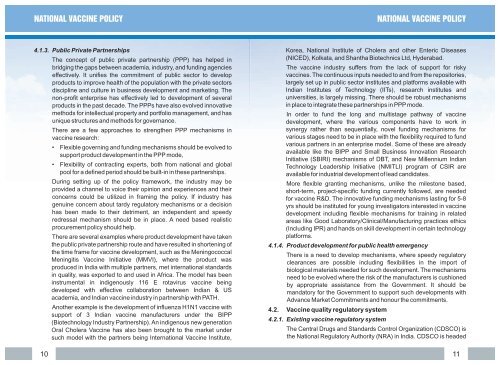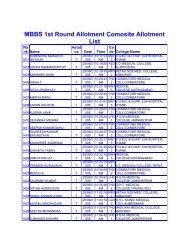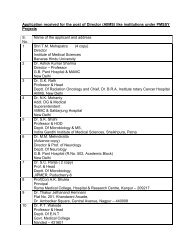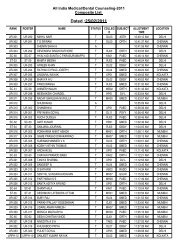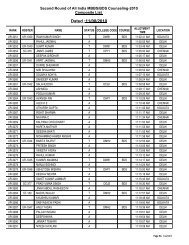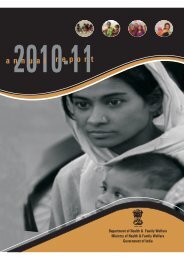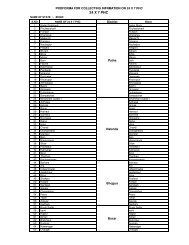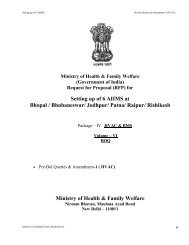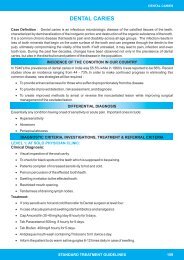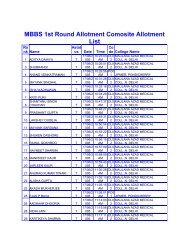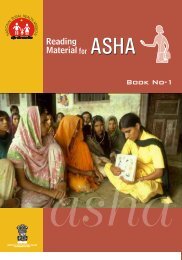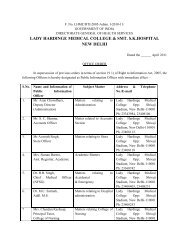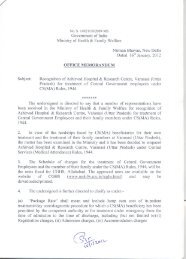National Vaccine Policy Book - Ministry of Health and Family Welfare
National Vaccine Policy Book - Ministry of Health and Family Welfare
National Vaccine Policy Book - Ministry of Health and Family Welfare
Create successful ePaper yourself
Turn your PDF publications into a flip-book with our unique Google optimized e-Paper software.
4.1.3. Public Private Partnerships<br />
The concept <strong>of</strong> public private partnership (PPP) has helped in<br />
bridging the gaps between academia, industry, <strong>and</strong> funding agencies<br />
effectively. It unifies the commitment <strong>of</strong> public sector to develop<br />
products to improve health <strong>of</strong> the population with the private sectors<br />
discipline <strong>and</strong> culture in business development <strong>and</strong> marketing. The<br />
non-pr<strong>of</strong>it enterprise has effectively led to development <strong>of</strong> several<br />
products in the past decade. The PPPs have also evolved innovative<br />
methods for intellectual property <strong>and</strong> portfolio management, <strong>and</strong> has<br />
unique structures <strong>and</strong> methods for governance.<br />
There are a few approaches to strengthen PPP mechanisms in<br />
vaccine research:<br />
• Flexible governing <strong>and</strong> funding mechanisms should be evolved to<br />
support product development in the PPP mode,<br />
• Flexibility <strong>of</strong> contracting experts, both from national <strong>and</strong> global<br />
pool for a defined period should be built-in in these partnerships.<br />
During setting up <strong>of</strong> the policy framework, the industry may be<br />
provided a channel to voice their opinion <strong>and</strong> experiences <strong>and</strong> their<br />
concerns could be utilized in framing the policy. If industry has<br />
genuine concern about tardy regulatory mechanisms or a decision<br />
has been made to their detriment, an independent <strong>and</strong> speedy<br />
redressal mechanism should be in place. A need based realistic<br />
procurement policy should help.<br />
There are several examples where product development have taken<br />
the public private partnership route <strong>and</strong> have resulted in shortening <strong>of</strong><br />
the time frame for vaccine development, such as the Meningococcal<br />
Meningitis <strong>Vaccine</strong> Initiative (MMVI), where the product was<br />
produced in India with multiple partners, met international st<strong>and</strong>ards<br />
in quality, was exported to <strong>and</strong> used in Africa. The model has been<br />
instrumental in indigenously 116 E rotavirus vaccine being<br />
developed with effective collaboration between Indian & US<br />
academia, <strong>and</strong> Indian vaccine industry in partnership with PATH.<br />
Another example is the development <strong>of</strong> influenza H1N1 vaccine with<br />
support <strong>of</strong> 3 Indian vaccine manufacturers under the BIPP<br />
(Biotechnology Industry Partnership). An indigenous new generation<br />
Oral Cholera <strong>Vaccine</strong> has also been brought to the market under<br />
such model with the partners being International <strong>Vaccine</strong> Institute,<br />
Korea, <strong>National</strong> Institute <strong>of</strong> Cholera <strong>and</strong> other Enteric Diseases<br />
(NICED), Kolkata, <strong>and</strong> Shantha Biotechnics Ltd, Hyderabad.<br />
The vaccine industry suffers from the lack <strong>of</strong> support for risky<br />
vaccines. The continuous inputs needed to <strong>and</strong> from the repositories,<br />
largely set up in public sector institutes <strong>and</strong> platforms available with<br />
Indian Institutes <strong>of</strong> Technology (IITs), research institutes <strong>and</strong><br />
universities, is largely missing. There should be robust mechanisms<br />
in place to integrate these partnerships in PPP mode.<br />
In order to fund the long <strong>and</strong> multistage pathway <strong>of</strong> vaccine<br />
development, where the various components have to work in<br />
synergy rather than sequentially, novel funding mechanisms for<br />
various stages need to be in place with the flexibility required to fund<br />
various partners in an enterprise model. Some <strong>of</strong> these are already<br />
available like the BIPP <strong>and</strong> Small Business Innovation Research<br />
Initiative (SBIRI) mechanisms <strong>of</strong> DBT, <strong>and</strong> New Millennium Indian<br />
Technology Leadership Initiative (NMITLI) program <strong>of</strong> CSIR are<br />
available for industrial development <strong>of</strong> lead c<strong>and</strong>idates.<br />
More flexible granting mechanisms, unlike the milestone based,<br />
short-term, project-specific funding currently followed, are needed<br />
for vaccine R&D. The innovative funding mechanisms lasting for 5-8<br />
yrs should be instituted for young investigators interested in vaccine<br />
development including flexible mechanisms for training in related<br />
areas like Good Laboratory/Clinical/Manufacturing practices ethics<br />
(Including IPR) <strong>and</strong> h<strong>and</strong>s on skill development in certain technology<br />
platforms.<br />
4.1.4. Product development for public health emergency<br />
There is a need to develop mechanisms, where speedy regulatory<br />
clearances are possible including flexibilities in the import <strong>of</strong><br />
biological materials needed for such development. The mechanisms<br />
need to be evolved where the risk <strong>of</strong> the manufacturers is cushioned<br />
by appropriate assistance from the Government. It should be<br />
m<strong>and</strong>atory for the Government to support such developments with<br />
Advance Market Commitments <strong>and</strong> honour the commitments.<br />
4.2. <strong>Vaccine</strong> quality regulatory system<br />
4.2.1. Existing vaccine regulatory system<br />
The Central Drugs <strong>and</strong> St<strong>and</strong>ards Control Organization (CDSCO) is<br />
the <strong>National</strong> Regulatory Authority (NRA) in India. CDSCO is headed<br />
10 11


